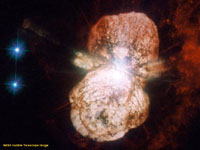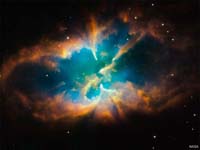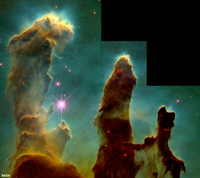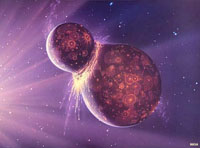1.29: Nebular Hypothesis of the Origin of the Solar System
- Page ID
- 9745
Nebular Hypothesis of the Origin of the Solar System
Many billions of years before the formation of the Solar System there were probably several generations of star formation and destruction occurred in our region of the Milky Way. Ancient supernova explosions in the distant past produced the elements we observe in our Solar System today (an example of a fairly recent supernova explosion is shown in Figure 1.80). Nuclear fusion in stars coverts hydrogen into helium and other elements up to the atomic mass of iron. Elements heavier than iron are only created by intense energy in supernova explosions. Gas, dust, and other matter from previous supernova explosions became part of a nebula (Figures 1-81). Gravity gradually condenses material in nebulae into new star systems (see example in Figure 1.82).
An ancient nebula in the Milky Way Galaxy was the birthplace of our Sun and Solar System. Currents of material (gases, dust, asteroids, etc.) under the influence of gravity consolidated into the proto suns and proto planets of new star systems within the nebula, one of which became our Sun and Solar System. Because all matter is influenced by gravity, matter within nebulae gradually is pulled toward areas with more matter. As matter moves toward a location with greater density it may be caught in a spinning current around a center of accumulating matter that may become a sun or a planet.
• The combination of gravity and spin results in the formation of a flat, disk-shaped stellar cloud with the Proto Sun (or pre Sun) at the center. The increasing mass and gravity of the Sun grabs most of the matter in the evolving Solar System (Figure 1.83).
• The Sun eventually gains enough mass that nuclear fusion can begin, creating the intense energy that it radiates into space.
• The massive release of energy from the new Sun heats the surrounding stellar region, combined with the force of high energy plasma (the solar wind) pushes the light elements (mostly hydrogen and helium) out of the inner Solar System region. As a result:
• Inner planets form from the accumulation mostly of metallic and rocky substances (dust). Lighter gas materials are pushed to the outer regions of the Solar System.
• Larger planets in the outer part of the Solar System began forming from gases (mostly hydrogen) and fragments of ice (H2O, CO2, and other gases).
• The Sun and its Solar System gradually formed by the gravitational attraction of materials within a stellar nebula beginning almost 5 billion years ago.
• The evolving Solar System assumes a flat, disk shape of condensing gases and dust with the Proto Sun (or pre Sun) at the center. The consolidation of matter under gravitational attraction causes the surrounding nebular cloud to flatten and spin.
• After solar ignition (initiation of the Sun's internal nuclear fusion reactions), the Sun's intense solar energy and solar wind begins to drive gases away from the inner Solar System.
• Inner planets begin to form from metallic and rocky substances (dust).
• Larger outer planets began forming from fragments of ice (H2O, CO2, and others).
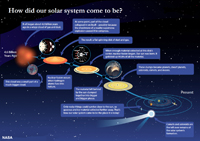
Figure 1.83. A brief explanation of how the Solar System came to be through the process of stellar evolution.
Proto-Earth Formed
Studies of meteorites and samples from the Moon suggest that the Sun and our Solar System (including proto-planets) condensed and formed in a nebula before or about 4.56 billion years ago. A recent Scientific American article places the current assumed age of the Earth is about 4.56 billion years old. Currently, the oldest samples of Early Earth rock samples from the Jack Hills region of Australia that contain crystals of the mineral zircon dated to an age of about 4.4 billion years.
Earth also formed through gravitational attraction of interstellar dust, gases, small asteroids and larger objects (planetesimals) within the early Solar System consolidating within the Sun's stellar nebula and within its orbital belt around the Sun.
• Initially, the Earth was probably homogeneous in composition, eventually becoming extremely hot and mostly molten within.
• Proto-Earth was probably under constant bombardment by asteroids, comets, and planetary dusts and debris.
• Current thought is that the Proto-Earth grew to a larger in size than today’s Earth.
Formation of the Earth-Moon System
Proto-Earth experienced a great planetary collision resulting in formation of the Moon.
Studies of the rocks brought back from the Apollo Missions show that the Earth and Moon have similar mineral and isotopic compositions. Such an impact probably vaporized much of the upper portion of the Proto-Earth, throwing much of it into space. Gravity eventually consolidated the material into the Earth-Moon system. This, and the fact that the Earth has a tilted axis, and the Moon's orbit is not in the ecliptic plane, suggest that the Moon may have formed from the collision of another small planet-sized object with the Earth early in the history of the Solar System (Figure 1.84). It is this tilt to Earth's axis that gives rise to the seasons as it orbits the Sun.
The Moon's surface displays a heavily cratered surface, many of the craters are massive in scale. Dark-colored maria are regions on the lunar surface where molten material flooded the surface, filling in depressions created by massive impacts. The lighter-colored highland regions on the Moon are rugged mountainous regions consisting of heavily cratered moonscapes and tectonic features that formed early in the Moon's history when the mantle was more molten and lighter material floated to the surface to crystallize and form the lunar crust. The cratering was a result of asteroids and comets collisions, mostly within the first billion years of the Moon's history.



